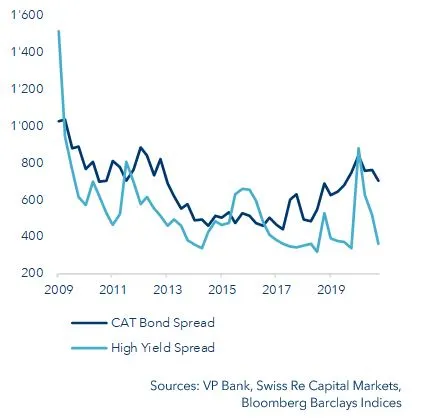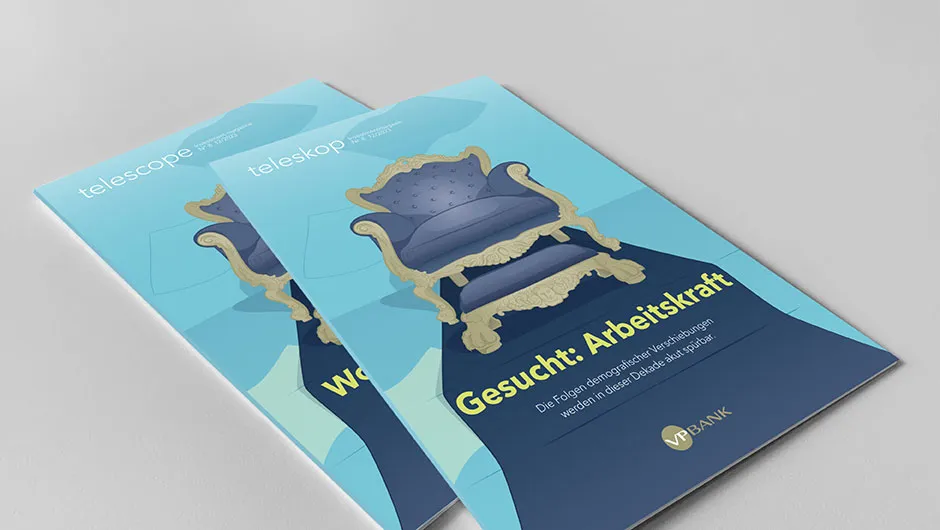Higher potential return despite lower risk
In terms of insurance-linked securities (ILSs), the crucial factor is the hurricane outlook for the USA – and the initial preliminary forecasts for the 2021 Atlantic hurricane season have already been released: 7 hurricanes (3 of them severe) and 16 named tropical storms are expected to develop. This is essentially in line with the average of the past ten years. By way of comparison: 13 hurricanes and 30 named storms were recorded last year as a result of the La Niña weather phenomenon. And it was only the third time in modern meteorological history that six hurricanes actually made landfall in the United States. Fortunately, the full force of those storms centred mainly on sparsely populated areas, hence the damage remained within expectations at USD 60 to 65 billion. Most of the related losses were either uninsured or only partially covered by insurance companies. ILSs, which indemnify damages of this kind, came away relatively unscathed from their obligation to pay. The 2020 performance of the Swiss Re Cat Bond Index, which mirrors the securitised ILS catastrophe-bond segment, was therefore quite satisfactory at +5.8% despite these numerous storms.
For that reason, ILSs have long been on the radar of many investors seeking some sort of reasonable return in the wake of the 2008/09 financial crisis. This heightened demand had the effect of pressuring the risk premiums on Cat bonds (i.e. catastrophe bonds) in the same direction as credit spreads for corporate bonds (see chart).
However, that correlation has gone astray since 2017 as a result of various disasters. The 2017 storm damage from hurricanes Harvey, Irma and Maria totalled USD 278 billion. Wildfires in California led to once-in-a-century losses in 2018. And the Japanese typhoons in 2019 were also costly. In response, investors have recalibrated these risks: premiums currently stand at about 7%, up from a low of 4.4% in 2017. When one weighs that risk premium against an anticipated loss of 2.2% from natural catastrophes, it becomes clear that the net premium for the ILS asset class is significantly more attractive than that to be had in the corporate bond sector, where central bank measures have caused a significant distortion.
Risk premiums on Cat bonds vs. high-yield bonds

Insurance-linked securities as an asset class
Despite their being frequently structured as bonds in a legal sense, ILSs differ significantly from traditional bonds. Typically, Cat bonds and ILS strategies are considered members of the alternative investment asset class.
In a role similar to that of a reinsurer, investors receive insurance premiums for assuming peak risks associated with insured events such as tropical cyclones, earthquakes and other natural disasters. Cat bonds are a securitised form of the underlying insurance policies; their value is marked-to-market on a daily basis and market makers ensure sufficient liquidity for trading purposes.
One advantage here is the low correlation Cat bonds have with traditional asset classes, hence their high diversification benefit for the portfolio. Moreover, unlike corporate bonds or equities, they also show no correlation with economic cycles. A further distinction is drawn in terms of interest rate risk: Cat bonds are structured as floating rate notes with relatively short terms to maturity, which makes them much less susceptible to rising interest rates.
In our opinion, the ILS segment is sustainable in its nature. The broader investor base frees up financial resources for traditional reinsurance companies, and this ultimately accrues to the benefit of policyholders as well. Some Cat bonds are designed to provide immediate funding for the restoration of destroyed infrastructure.
For more information please contact your client advisor.
Important legal information
This document was produced by VP Bank AG (hereinafter: the Bank) and distributed by the companies of VP Bank Group. This document does not constitute an offer or an invitation to buy or sell financial instruments. The recommendations, assessments and statements it contains represent the personal opinions of the VP Bank AG analyst concerned as at the publication date stated in the document and may be changed at any time without advance notice. This document is based on information derived from sources that are believed to be reliable. Although the utmost care has been taken in producing this document and the assessments it contains, no warranty or guarantee can be given that its contents are entirely accurate and complete. In particular, the information in this document may not include all relevant information regarding the financial instruments referred to herein or their issuers.
Additional important information on the risks associated with the financial instruments described in this document, on the characteristics of VP Bank Group, on the treatment of conflicts of interest in connection with these financial instruments and on the distribution of this document can be found at https://www.vpbank.com/legal_notice_en



Add the first comment